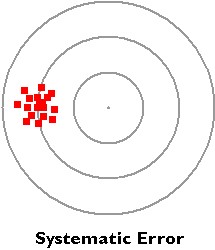Systematic Errors
Key point
- A systematic error is an error that is introduced by an inaccuracy in a lab procedure than by random occurrence.
- Systematic errors displace data measurements from their true value in the same direction and by the same magnitude.
- Inconsistencies in the y-intercept of the graphed data is often indicative of systematic error.
What is systematic error in physics? A systematic error is a type of error that affects the accuracy of data collected in an experiment.
Systematic errors displace data measurements from their true value in the same direction and by the same magnitude; for example, all the measurements may all be too large or too small.
- This displacement or “shift” affects the intercepts of the graph for the data.
- A non-zero y intercept where an intercept of (0,0) is expected is indicative of systematic error in the data collection process.
In the bulls eye example to the right, all of the data points are skewed to the left, where they are supposed to be at the center.
Systematic errors are commonly associated with set-up error such as improper calibration. A common example may be:
- An electric scale that is not set to zero before measuring any masses.
Frequently Asked Questions
- How can systematic error be reduced, minimized, or eliminated?
- It cannot be completely eliminated, as no lab procedure is perfect.
- Minimize it by calibrating equipment, warming up instruments, and comparing measured values against accepted values/standards.
Subscribe to the Inertia Newsletter
IB News, Covid-19 Updates, Deadlines, Tips and Tricks, and Hundreds of Free Resources are Awaiting You!
Features
- Study Notes
- Thousands of IB Questions
- Detailed Answers
- Ask-A-Question System


